Defects Detection and Localization in Underwater Plates Using Laser Laterally Generated Pure Non-Dispersive S0 Mode
Abstract
:Featured Application
Abstract
1. Introduction
2. Materials and Methods
2.1. Mode Selection of Lamb Waves for Defect Detection in Underwater Plates
2.2. Sample and Experimental Setup
3. Results
4. Discussion
- (1)
- By using a laser ultrasonic technique for excitation and detection, the system can realize remote non-contact detection.
- (2)
- The S0 mode generated by lateral generation configuration has good SNR and can propagate a longer distance, while the amplitude of the A0 mode is significantly restrained.
- (3)
- The mode conversion can be an effective tool for defect detection and localization.
- (4)
- Because of the non-dispersion and narrow wave packet of the S0 mode using lateral generation configuration, defect width can be estimated, and multiple defects with short spatial intervals can be detected.
5. Conclusions
Author Contributions
Funding
Conflicts of Interest
References
- Nordbø, H. NDE—Overview and Legal Requirements. In Submersible Technology; Springer: Berlin, Germany, 1986; pp. 183–187. [Google Scholar]
- Bayliss, M.; Short, D.; Bax, M. Underwater Inspection; E & FN Spon: London, UK, 1988. [Google Scholar]
- Mandal, K.; Dufour, D.; Krause, T.W.; Atherton, D.L. Investigations of magnetic flux leakage and magnetic Barkhausen noise signals from pipeline steel. J. Phys. D 1997, 30, 962. [Google Scholar] [CrossRef]
- Udpa, L.; Mandayam, S.; Udpa, S.; Sun, Y.; Lord, W. Developments in gas pipeline inspection technology. Mater. Eval. 1996, 54, 4. [Google Scholar]
- Na, W.B.; Kundu, T. Underwater Pipeline Inspection Using Guided Waves. J. Press. Vessel Technol. 2002, 124, 196–200. [Google Scholar] [CrossRef]
- Chen, J.; Su, Z.; Cheng, L. Identification of corrosion damage in submerged structures using fundamental anti-symmetric Lamb waves. Smart Mater. Struct. 2010, 19, 015004. [Google Scholar] [CrossRef]
- Rizzo, P. NDE/SHM of Underwater Structures: A Review; Trans Tech Publications: Princeton, NJ, USA, 2013; pp. 208–216. [Google Scholar]
- Ghosh, T.; Kundu, T.; Karpur, P. Efficient use of Lamb modes for detecting defects in large plates. Ultrasonics 1998, 36, 791–801. [Google Scholar] [CrossRef]
- Kessler, S.S.; Spearing, S.M.; Soutis, C. Damage detection in composite materials using Lamb wave methods. Smart Mater. Struct. 2002, 11, 269. [Google Scholar] [CrossRef]
- Tua, P.; Quek, S.; Wang, Q. Detection of cracks in plates using piezo-actuated Lamb waves. Smart Mater. Struct. 2004, 13, 643. [Google Scholar] [CrossRef]
- Kim, H.; Jhang, K.; Shin, M.; Kim, J. A noncontact NDE method using a laser generated focused-Lamb wave with enhanced defect-detection ability and spatial resolution. Ndt E Int. 2006, 39, 312–319. [Google Scholar] [CrossRef]
- Jhang, K.-Y.; Shin, M.J.; Lim, B.O. Application of the laser generated focused-Lamb wave for non-contact imaging of defects in plate. Ultrasonics 2006, 44, e1265–e1268. [Google Scholar] [CrossRef]
- Clough, A.; Edwards, R. Characterisation of hidden defects using the near-field ultrasonic enhancement of Lamb waves. Ultrasonics 2015, 59, 64–71. [Google Scholar] [CrossRef] [Green Version]
- Achenbach, J. Wave Propagation in Elastic Solids; Elsevier: Amsterdam, The Netherlands, 2012; Volume 16. [Google Scholar]
- Alleyne, D.N.; Cawley, P. The interaction of Lamb waves with defects. IEEE Trans. Ultrason. Ferroelectr. Freq. Control 1992, 39, 381–397. [Google Scholar] [CrossRef] [PubMed]
- Giurgiutiu, V. Lamb wave generation with piezoelectric wafer active sensors for structural health monitoring. In Proceedings of the Smart Structures and Materials 2003: Smart Structures and Integrated Systems, San Diego, CA, USA, 3–6 March 2003; pp. 111–123. [Google Scholar]
- Lemistre, M.; Balageas, D. Structural health monitoring system based on diffracted Lamb wave analysis by multiresolution processing. Smart Mater. Struct. 2001, 10, 504. [Google Scholar] [CrossRef]
- Diligent, O.; Grahn, T.; Boström, A.; Cawley, P.; Lowe, M.J. The low-frequency reflection and scattering of the S0 Lamb mode from a circular through-thickness hole in a plate: Finite Element, analytical and experimental studies. J. Acoust. Soc. Am. 2002, 112, 2589–2601. [Google Scholar] [CrossRef] [PubMed]
- Lowe, M.J.; Diligent, O. Low-frequency reflection characteristics of the s0 Lamb wave from a rectangular notch in a plate. J. Acoust. Soc. Am. 2002, 111, 64–74. [Google Scholar] [CrossRef]
- Moilanen, P.; Nicholson, P.; Kilappa, V.; Cheng, S.; Timonen, J. Measuring guided waves in long bones: Modeling and experiments in free and immersed plates. Ultrasound Med. Biol. 2006, 32, 709–719. [Google Scholar] [CrossRef]
- Bagheri, A.; Rizzo, P. Guided ultrasonic wave testing of an immersed plate with hidden defects. Opt. Eng. 2015, 55, 011003. [Google Scholar] [CrossRef]
- Gao, G.; Deng, M.; Li, M.; Pei, J. Mode selection of Lamb waves for the evaluation of solid plates with liquid loading. Sci. China Phys. Mech. Astron. 2014, 57, 1840–1847. [Google Scholar] [CrossRef]
- Sharma, S.; Mukherjee, A. Ultrasonic guided waves for monitoring corrosion in submerged plates. Struct. Control Health Monit. 2015, 22, 19–35. [Google Scholar] [CrossRef]
- Takiy, A.E.; Kitano, C.; Higuti, R.T.; Granja, S.C.; Prado, V.T.; Elvira, L.; Martínez-Graullera, O. Ultrasound imaging of immersed plates using high-order Lamb modes at their low attenuation frequency bands. Mech. Syst. Signal Process. 2017, 96, 321–332. [Google Scholar] [CrossRef]
- Rizzo, P.; Han, J.-G.; Ni, X.-L. Structural health monitoring of immersed structures by means of guided ultrasonic waves. J. Intell. Mater. Syst. Struct. 2010, 21, 1397–1407. [Google Scholar] [CrossRef]
- Pistone, E.; Li, K.; Rizzo, P. Noncontact monitoring of immersed plates by means of laser-induced ultrasounds. Struct. Health Monit. 2013, 12, 549–565. [Google Scholar] [CrossRef]
- Lee, J.R.; Jang, J.K.; Kong, C.W. Fully Noncontact Wave Propagation Imaging in an Immersed Metallic Plate with a Crack. Shock Vib. 2014, 2014, 895693. [Google Scholar] [CrossRef]
- Xie, Q.; Yan, S.; Lu, J.; Ni, C.; Ni, X.; Shen, Z. Defect Detection Using the Lamb Mode S0 by Pulsed Laser Laterally Illuminating on a Side of the Plate. Int. J. Thermophys. 2018, 39, 123. [Google Scholar] [CrossRef]
- Cegla, F.B.; Cawley, P.; Lowe, M.J.S. Material property measurement using the quasi-Scholte mode—A waveguide sensor. J. Acoust. Soc. Am. 2005, 117, 1098–1107. [Google Scholar] [CrossRef]
- Rose, J.L. Ultrasonic Guided Waves in Solid Media; Cambridge University Press: Cambridge, UK, 2014. [Google Scholar]
- Hayashi, T.; Inoue, D. Calculation of leaky Lamb waves with a semi-analytical finite element method. Ultrasonics 2014, 54, 1460–1469. [Google Scholar] [CrossRef] [PubMed]
- Mirahmadi, S.J.; Honarvar, F. Application of signal processing techniques to ultrasonic testing of plates by S0 Lamb wave mode. NDT E Int. 2011, 44, 131–137. [Google Scholar] [CrossRef]
- Chen, L.; Dong, Y.; Meng, Q.; Liang, W. FEM simulation for Lamb Wave evaluate the defects of plates. In Proceedings of the 2012 International Workshop on Microwave and Millimeter Wave Circuits and System Technology, Chengdu, China, 19–20 April 2012; pp. 1–4. [Google Scholar]
- Ghadami, A.; Behzad, M.; Mirdamadi, H.R. A mode conversion-based algorithm for detecting rectangular notch parameters in plates using Lamb waves. Arch. Appl. Mech. 2015, 85, 793–804. [Google Scholar] [CrossRef]
- Alleyne, D.N.; Lowe, M.J.S.; Cawley, P. The Reflection of Guided Waves from Circumferential Notches in Pipes. J. Appl. Mech. 1998, 65, 635–641. [Google Scholar] [CrossRef]
- Inoue, D.; Hayashi, T. Transient analysis of leaky Lamb waves with a semi-analytical finite element method. Ultrasonics 2015, 62, 80–88. [Google Scholar] [CrossRef] [PubMed]
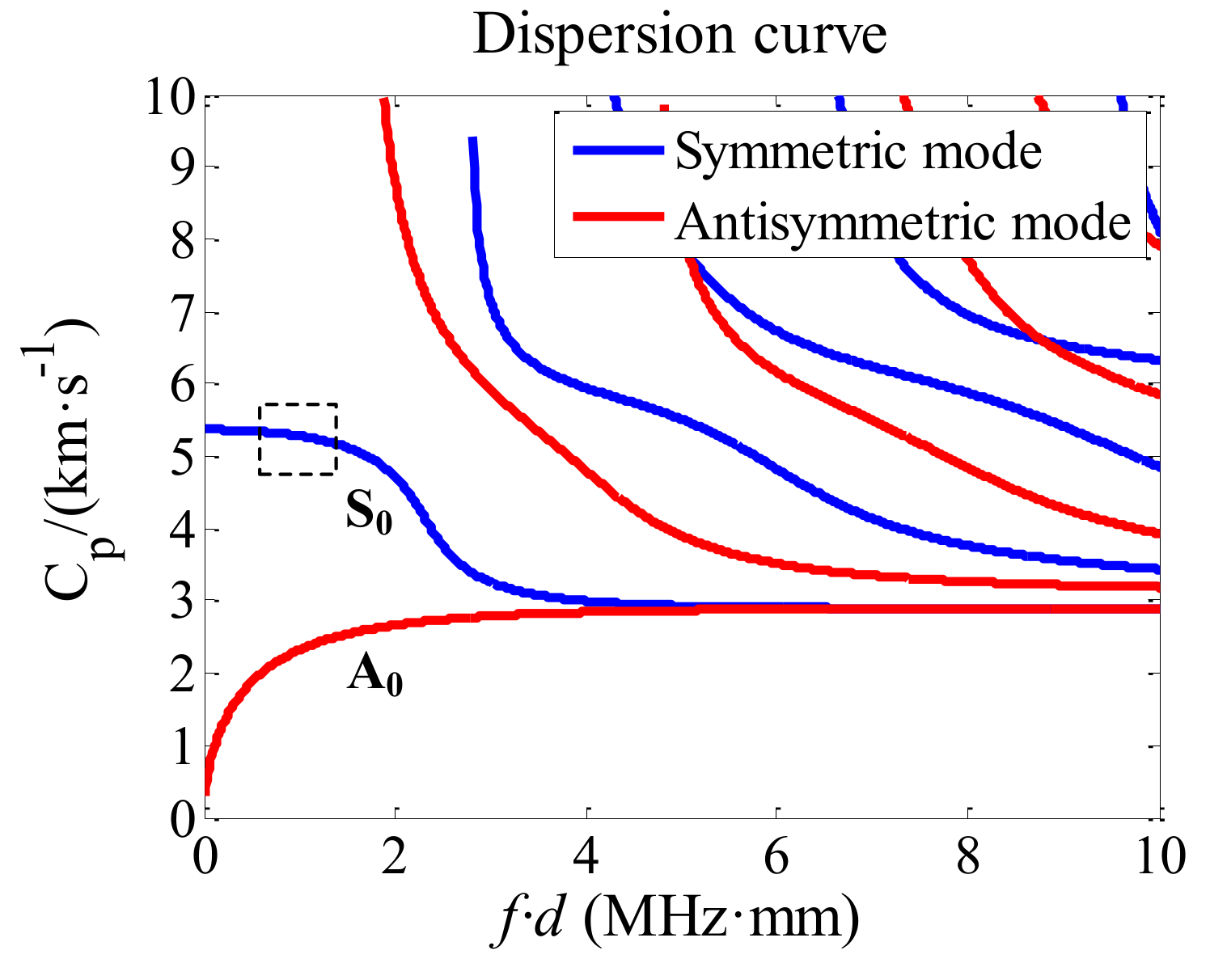

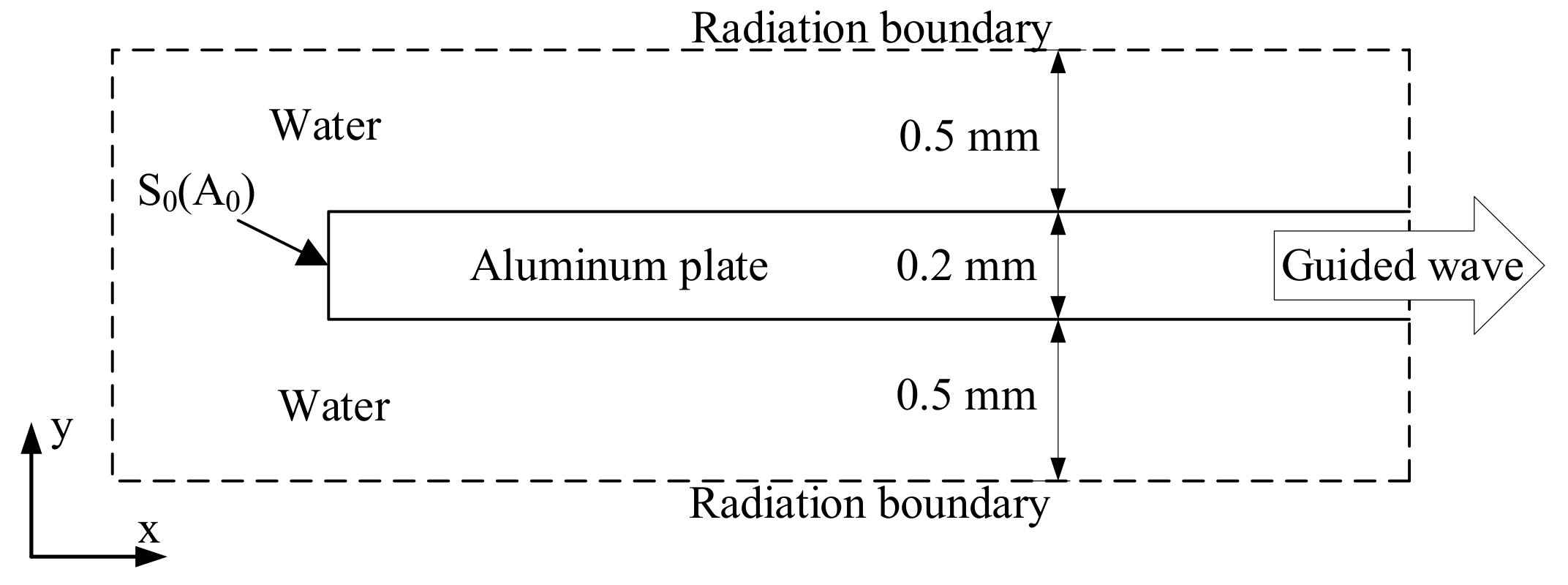


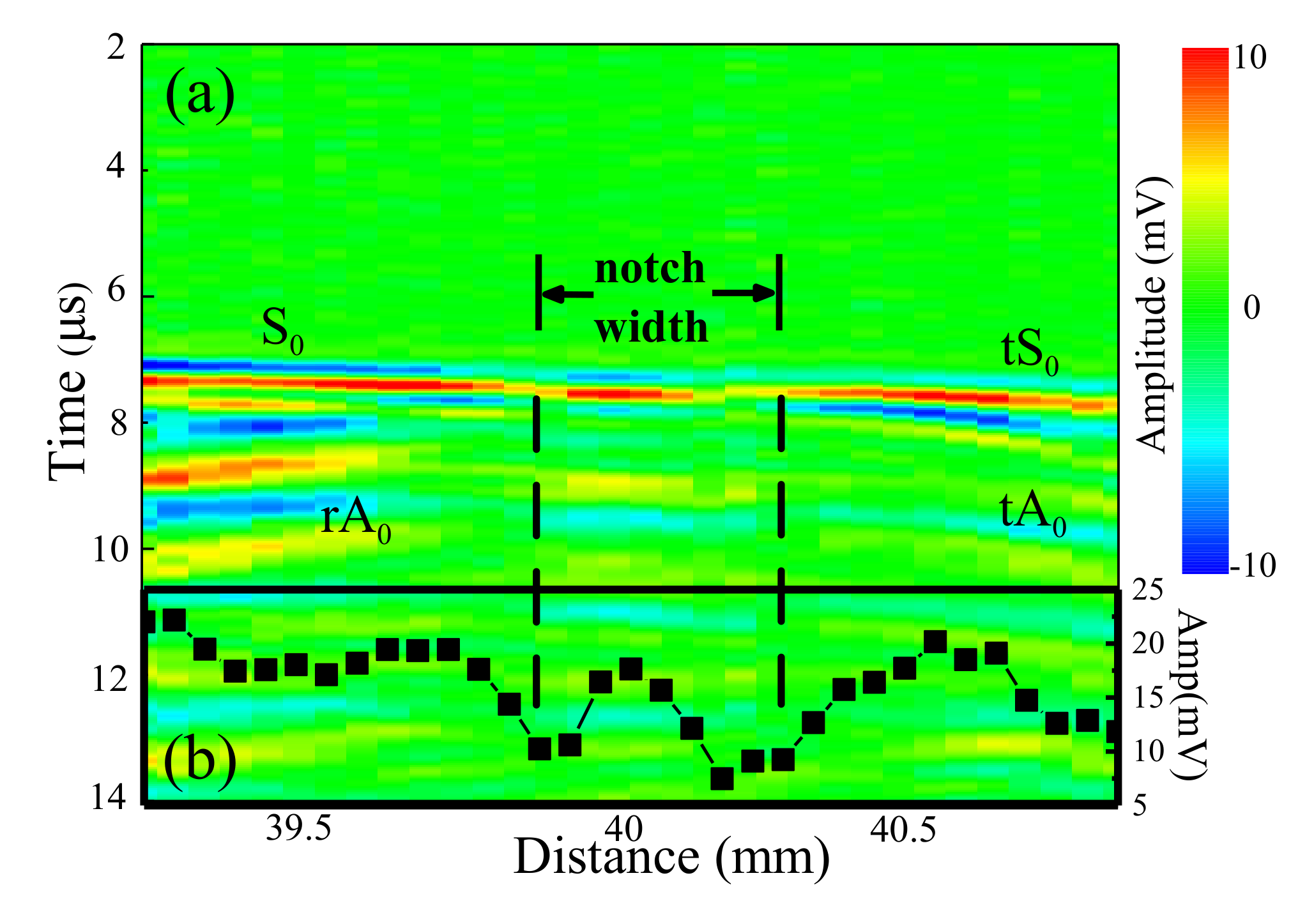
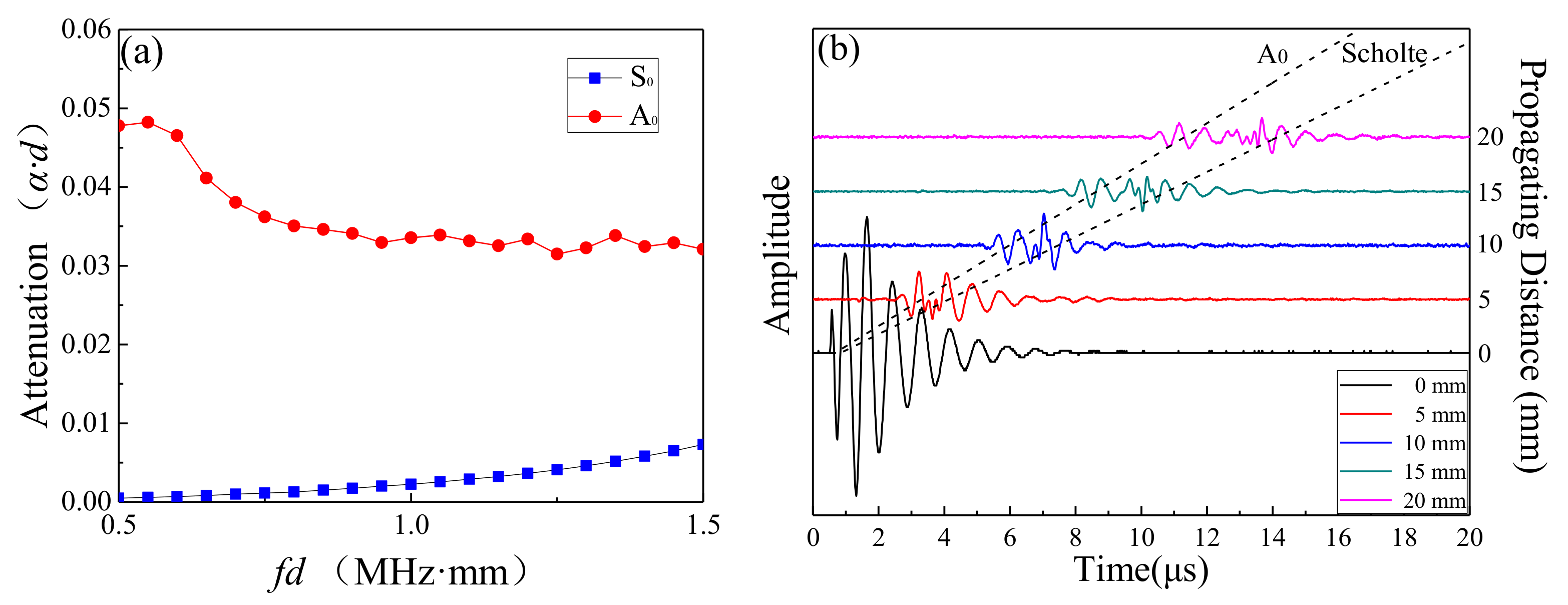

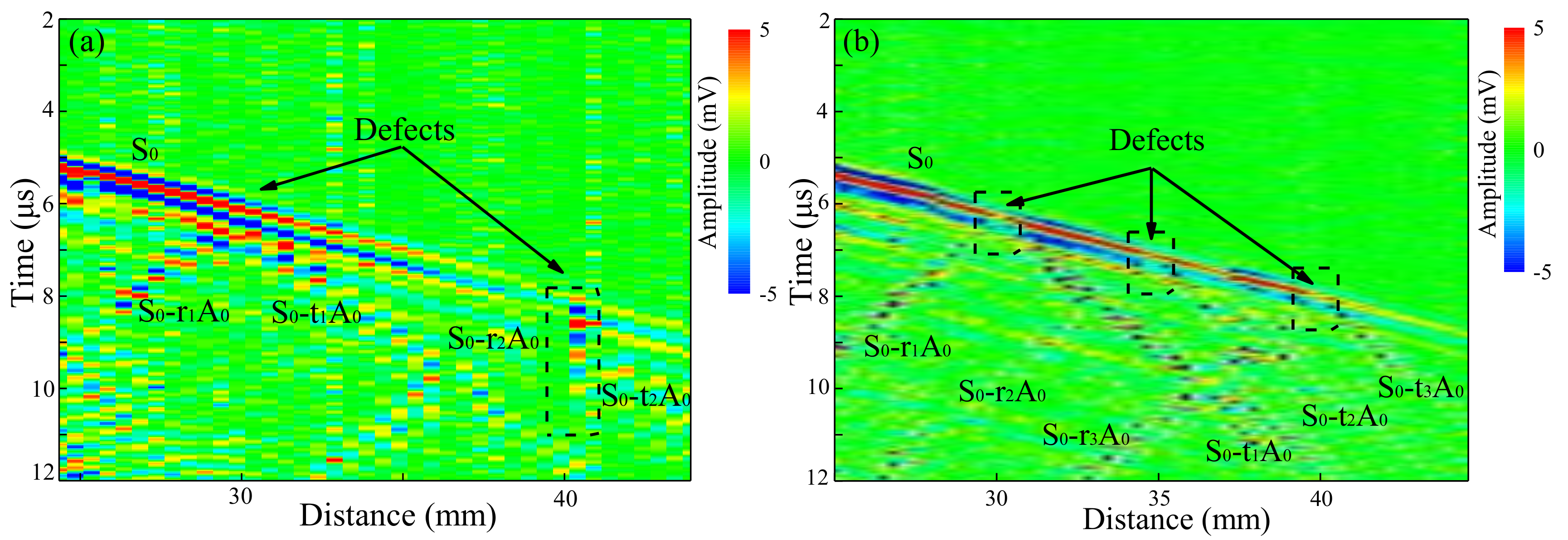
| Density (kg/m3) | CT (km/s) | CL (km/s) | Young’s Modulus GPa | |
|---|---|---|---|---|
| Aluminum | 2700 | 3103 | 6176 | 70 |
| Water | 1000 |
© 2019 by the authors. Licensee MDPI, Basel, Switzerland. This article is an open access article distributed under the terms and conditions of the Creative Commons Attribution (CC BY) license (http://creativecommons.org/licenses/by/4.0/).
Share and Cite
Xie, Q.; Ni, C.; Shen, Z. Defects Detection and Localization in Underwater Plates Using Laser Laterally Generated Pure Non-Dispersive S0 Mode. Appl. Sci. 2019, 9, 459. https://doi.org/10.3390/app9030459
Xie Q, Ni C, Shen Z. Defects Detection and Localization in Underwater Plates Using Laser Laterally Generated Pure Non-Dispersive S0 Mode. Applied Sciences. 2019; 9(3):459. https://doi.org/10.3390/app9030459
Chicago/Turabian StyleXie, Qingnan, Chenyin Ni, and Zhonghua Shen. 2019. "Defects Detection and Localization in Underwater Plates Using Laser Laterally Generated Pure Non-Dispersive S0 Mode" Applied Sciences 9, no. 3: 459. https://doi.org/10.3390/app9030459





